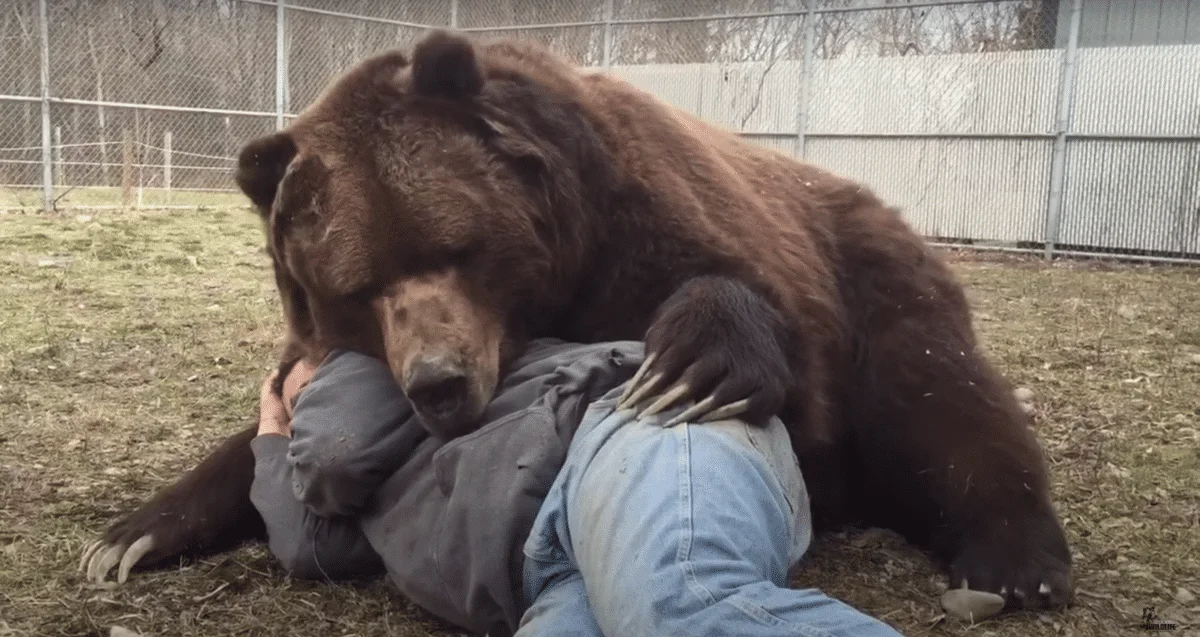Jim gets embraced by Jimbo the Bear! They have been best friends for 23 years, since Jimbo, the 1400 lb Kodiak bear, was just a cub.

Due to a hind leg injury that rendered him unable to fend for himself in the wild, Jimbo the bear established an enduring companionship with Jim and Susan at the Orphaned Wildlife Center. Here, he received lifelong care and support until his death of liver cancer in 2018. The bear was located at a non-profit Orphan Wildlife Center 60 miles north of New York. The bears located here can not be released because they are injured or they are too accustomed to captivity.
Witness how Jimbo the bear embraces Jim. Let me set the scene, a paw on his lap and, Jimbo, the bear’s big tongue slobbering onto Jim’s ear!
Check out: Mama Bear Brings Her Cubs To Backyard Pool For A Dip.
The Embrace
Bears Behavior
Bears in captivity can exhibit friendliness for several reasons, although it’s important to note that individual bear behavior can vary widely based on factors such as species, upbringing, genetics, and the conditions of their captivity. Some reasons why bears might appear friendly in captivity include:
1. Early Socialization
Bears raised in captivity from a young age and exposed to regular human interaction can become accustomed to human presence, potentially displaying friendliness as a result.
2. Dependency on Humans
In some cases, bears in captivity might associate humans with the provision of food, water, and care. This can lead to a level of comfort and apparent friendliness towards humans.
3. Lack of Threats
Captive bears may not perceive humans as threats since they are not exposed to the natural predators, competitors, or territorial challenges they face in the wild.
4. Routine and Predictability
Captive environments often provide a routine and predictable schedule, which some bears might find comforting. This predictability can contribute to a sense of ease around humans.
5. Selective Breeding
Some captive bears may come from generations of bears that have been more docile or tolerant of human presence. Over time, this could lead to a genetic predisposition towards friendliness.
6. Learning Behavior
Bears are intelligent animals capable of learning from their surroundings. If they see that behaving in a certain way (such as being calm and friendly) results in rewards or positive interactions, they might continue that behavior.
7. Conditioning
Through positive reinforcement techniques, trainers or caretakers might condition bears to exhibit specific behaviors, including friendliness, in exchange for rewards.
However, it’s crucial to remember that bears are wild animals with natural behaviors and instincts that can’t be completely eradicated. Even seemingly friendly captive bears can potentially become unpredictable or exhibit aggressive behaviors. One should always interact with captive bears with proper safety precautions and a clear understanding of the animal’s needs and nature.
Check out: Bear Cub Saved After Being Trapped Within Plastic Container.
If you enjoyed this article as much as me, check out our related article links below!
Next up:
- Watch Guy Jump Into Ice Water To Save Deer With Bucket Stuck On Head - April 25, 2024
- Watch Couple Stampeded by Herd Of Bison - April 25, 2024
- Watch Snake Vs Mongoose Fight - April 25, 2024



Vanessa Duarte
Thursday 31st of August 2023
Thank you Please subscribe to more news